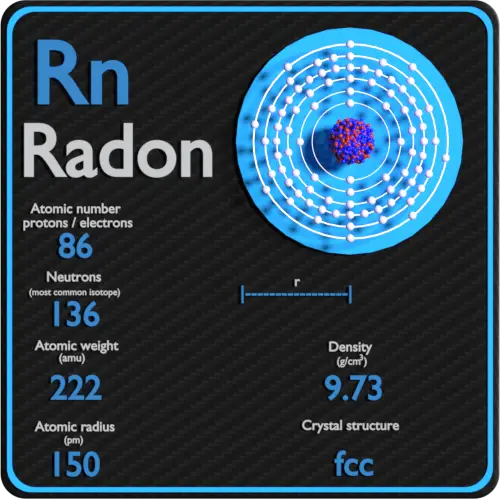Radon
| Atomic Number: | 86 | Atomic Radius: | 220 pm (Van der Waals) |
| Atomic Symbol: | Rn | Melting Point: | -71 °C |
| Atomic Weight: | 222 | Boiling Point: | -61.7 °C |
| Electron Configuration: | [Xe]6s24f145d106p6 | Oxidation States: | 6, 2, 0 |
Atomic Mass of Radon Atomic mass of Radon is 222 u. The atomic mass is the mass of an atom. The atomic mass or relative isotopic mass refers to the mass of a single particle, and therefore is tied to a certain specific isotope of an element. Radon has atomic mass of 222. There is isotope of Radon with mass number 226. Radon is a Nobel gas. ››More information on molar mass and molecular weight. In chemistry, the formula weight is a quantity computed by multiplying the atomic weight (in atomic mass units) of each element in a chemical formula by the number of atoms of that element present in the formula, then adding all.
History
The name was derived from radium; called niton at first, from the Latin word nitens meaning shining.The element was discovered in 1900 by Dorn, who called it radium emanation. In 1908 Ramsay and Gray, who named it niton, isolated the element and determined its density, finding it to be the heaviest known gas. It is essentially inert and occupies the last place in the zero group of gases in the Periodic Table. Since 1923, it has been called radon.
Isotopes
Radon Atomic Mass Number

Thirty-nine isotopes are known. Radon-222 is the most common. It has a half-life of 3.823 days and is an alpha emitter. It is estimated that every square mile of soil to a depth of 6 inches contains about 1 g of radium, which releases radon in tiny amounts into the atmosphere. Radon gas can collect in buildings, creating a health risk. The Environmental Protection Agency estimates that responsible for an estimated 20,000 lung cancer deaths each year. More on radon and health. Radon is present in some spring waters, such as those at Hot Springs, Arkansas. Trainz download station.
Radon Atomic Mass And Number
Properties
Radon is present in the atomosphere at very low concentrations. See Wikipedia for discussion of concentration. At ordinary temperatures radon is a colorless gas; when cooled below the freezing point, radon exhibits a brilliant phosphorescence which becomes yellow as the temperature is lowered and orange-red at the temperature of liquid air. Microsoft project 2016 for mac oregon. It has been reported that fluorine reacts with radon, forming a fluoride. Radon clathrates have also been reported.
Uses
Radon is still produced for therapeutic use by a few hospitals by pumping it from a radium source and sealing it in minute tubes, called seeds or needles, for application to patient. This practice has been largely discontinued as hospitals can get the seeds directly from suppliers, who make up the seeds with the desired activity for the day of use. Freddi fish download gratis mac.
Handling
Care must be taken in handling radon, as with other radioactive materials. The main hazard is from inhalation of the element and its solid daughters which are collected on dust in the air. Good ventilation should be provided where radium, thorium, or actinium is stored to prevent build-up of the element. Radon build-up is a health consideration in uranium mines. Recently radon build-up in homes has been a concern. Many deaths from lung cancer are caused by radon exposure. In the U.S. it is recommended that remedial action be taken if the air in homes exceeds 4 pCi/l.
